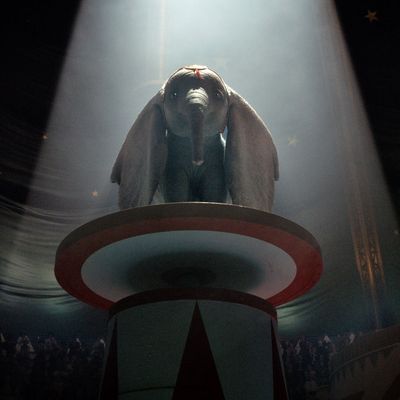
It was Tim Burton’s dreadful, garish, and bafflingly profitable live-action retooling of Alice in Wonderland that helped kick off the Disney-remake craze nearly a decade ago, so it’s understandable to expect the worst from Dumbo. The director has never handled sentiment well, and the original 1941 Dumbo is, in some ways, the softest and simplest of the first wave of Disney animated classics; the idea of that compact, understated tale of friendship and maternal love somehow fueling another ornate, bloated Tim Burton super-production sends chills up the spine. But the new Dumbo, as compromised as it is, somehow turns out to be one of the director’s better films of recent years — even as it reveals some of his more frustrating shortcomings.
Not unlike Alice, this live-action take on Dumbo only borrows the bare bones of its story from the original. Dumbo is still a big-eared Asian elephant born in a circus and initially dismissed as a freak, but his companions this time are humans, primarily World War I vet and amputee Holt Farrier (Colin Farrell) and his two kids, Joe and Milly (Finley Hobbins and Nico Parker), all of whom work for a traveling circus run by the boisterous and slightly shady Max Medici (Danny DeVito). The movie also takes from the original the tender bond between Dumbo and his protective mother, who is exiled after she rampages and kills a particularly harsh circus trainer. (And yes, we do get to hear a wonderful, new variation on the achingly tender song “Baby Mine.”)
The Farrier kids take over most of the narrative duties handled in the original by the scrappy Timothy Q. Mouse, who was basically a poor man’s Jiminy Cricket. But they’ve been given a lot more to do here. In the 1941 version, Dumbo doesn’t really fly until late in the story, a development that has the quality of a release, a catharsis. Here, it comes early — and as soon as the adorable little thing takes wing (or should that be “takes ear”?), Max gets a visit from V.A. Vandevere (Michael Keaton), a flamboyant, hot-shot New York carnival impresario, who whisks Dumbo and his human companions off to the infamous, massive Coney Island amusement park Dreamland.
The real-life version of that park, by the way, had already burned down by the year 1919, which is when Dumbo takes place, but I did get a kick out of the film’s attempt to recreate the place — and to give us an alternate, fictional reason for the cataclysmic fire that engulfed it. The colorful world of Dreamland and its many attractions might also remind viewers of Disneyland itself, which prompts interesting thoughts about what Burton might be saying here, as Dumbo gets exploited by the rapacious, seemingly kid-friendly capitalist Vandevere. Could the picture be an allegory for the director’s own time toiling in the Disney factory? Maybe, but Dumbo doesn’t lend much to that reading — most of the story and the dialogue here are pitched at the level of children’s fantasy, simple and direct and subtlety-free. And don’t expect any of that sly, irreverent edge of grown-up cynicism that Burton brought to so much of his early work. This is not the man who gave us Edward Scissorhands, and he hasn’t been for a while.
But here’s the good news: The circus settings do liberate Burton, giving him the opportunity to stage elaborate, bizarre acts with grandiosity and verve. Whether we’re watching Dumbo hoisted along a fake burning building to launch himself off a collapsing platform, or trying to navigate an ill-advised trapeze act, whenever the spotlights come on and the crowd roars, Dumbo comes to life. It helps also that Burton never lets us forget that we’re watching an elephant flying. The way the creature bops along awkwardly with each flap of his ears enhances the weirdness. We want to cheer, but we also want to laugh at the absurdity of it all. And the spectacle never gets tedious or tiresome (as it did in Alice and Dark Shadows) or confusing (as it did in Miss Peregrine’s Home for Peculiar Children). I could watch the circus scenes of this film forever, and thankfully, there are plenty of them.
So that’s what’s good about Dumbo. Here’s what’s bad: The story. The characters. Luckily there isn’t much of either. Dumbo himself is a marvel, a cuddly little weirdo who’s never quite anthropomorphized, and whose very animal sense of fear and bewilderment never leaves his face. We can sense Burton’s familiar empathy for those regarded as freaks in his portrayal of the creature. But the humans around Dumbo, none of whom emerges as any kind of narrative anchor, feel like cutouts. There has sometimes been a static blandness to the director’s pure dialogue scenes — his characters often stand still when they’re talking, as if they’re afraid to step out of storyboard position — and that’s often a problem here as well.
The actors do what they can. DeVito brings his trademark gusto to the part of a desperate circus owner, Keaton sports a dementedly dandyish swagger that is pure silliness, and Farrell cuts a dashing figure. But there’s only so much anyone can do to spruce up figures this one-dimensional. If the two kids who are ostensibly at the heart of this story had disappeared halfway through the movie, I’m not entirely sure I would have noticed.
And yet, it’s not hard to enjoy Dumbo. Like the circus owners and carnival crackpots who try to exploit the flying elephant for all he’s worth, Tim Burton still knows how to give us what we want. He may think of himself as the tormented freak on display, but he’s also clearly the all-powerful showman, ready to exploit our sense of wonder.





